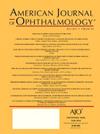Visual Impairment and Cognitive Function in Aging Adults: Sex and Age Differences in Mediating Effect of Social Isolation and Depression
IF 4.1
1区 医学
Q1 OPHTHALMOLOGY
引用次数: 0
Abstract
Purpose
Visual impairment (VI) is prevalent in older adults and associated with cognitive decline. However, the mechanisms through which visual impairment affects cognitive functioning during the aging process are poorly understood. Our study aims to estimate the direct effect of visual acuity on cognitive function and its indirect effect through social isolation and depressive symptoms by sex and age.
Design
Cross-sectional study.
Participants
117,231 individuals aged 40-70 participated in the UK Biobank baseline and ocular assessment. Of these, 81% were white, 54% were female, and 45.6% were aged 60-70. The mean age was 56.8 (SD 8.1) years.
Methods
Path analyses with multiple equations were conducted to examine the direct and indirect effects of visual acuity (VA). Stratified analyses by gender and age were performed.
Main Outcome Measures
LogMAR VA was the exposure, with social isolation and depressive symptoms as mediators. Cognitive functions, including visual memory, verbal-numerical reasoning, processing speed, and prospective memory, were the outcomes.
Results
VA had a direct effect on cognitive function (β = -0.979 for reasoning and OR = 0.67 for prospective memory). VA also influenced cognition indirectly through social isolation and depressive symptoms. The direct effect of VA on cognitive function was similar in men vs. women and middle-aged vs. older. However, there is a marked difference in the mediating effect via social isolation and depressive symptoms by age and sex. The mediating effect of VI on cognition via social isolation was stronger in older adults than middle-aged and in men than women; while the mediating effect via depressive symptoms was stronger in women and middle-aged individuals. VI had the largest mediating effect via social isolation in older males.
Conclusion and Relevance
Vision, social isolation, and depressive symptoms are modifiable factors and can be treated to preserve cognition. Encouraging social engagement among male and older adults with VI and promoting mental health awareness in women and middle-aged individuals with VI will reduce the negative impact of VI on cognition, lower dementia risk, and improve the well-being of aging adults.
求助全文
约1分钟内获得全文
求助全文
来源期刊
CiteScore
9.20
自引率
7.10%
发文量
406
审稿时长
36 days
期刊介绍:
The American Journal of Ophthalmology is a peer-reviewed, scientific publication that welcomes the submission of original, previously unpublished manuscripts directed to ophthalmologists and visual science specialists describing clinical investigations, clinical observations, and clinically relevant laboratory investigations. Published monthly since 1884, the full text of the American Journal of Ophthalmology and supplementary material are also presented online at www.AJO.com and on ScienceDirect.
The American Journal of Ophthalmology publishes Full-Length Articles, Perspectives, Editorials, Correspondences, Books Reports and Announcements. Brief Reports and Case Reports are no longer published. We recommend submitting Brief Reports and Case Reports to our companion publication, the American Journal of Ophthalmology Case Reports.
Manuscripts are accepted with the understanding that they have not been and will not be published elsewhere substantially in any format, and that there are no ethical problems with the content or data collection. Authors may be requested to produce the data upon which the manuscript is based and to answer expeditiously any questions about the manuscript or its authors.

 求助内容:
求助内容: 应助结果提醒方式:
应助结果提醒方式:


